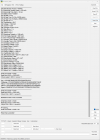Good Afternoon/Morning,
Having issues getting one of my batteries to charge which was in long term storage and won't turn on or accept any charge. Removed the casing and manually charged the battery to 11.8 volts ( 2 cells had no charge and one had 2.6 volts) and holding, all 3 cells are 3.9 volts each.
I have a cp2112 and got it communicating with the DJI battery killer app, i can unseal, clear PF and reset but the battery still fails to turn on, done some more research and found 2 write word codes 00 0024 and 00 0029 which write successfully but still not turning on.
is there any other commands that need to be sent?
Have attached screenshots.


Having issues getting one of my batteries to charge which was in long term storage and won't turn on or accept any charge. Removed the casing and manually charged the battery to 11.8 volts ( 2 cells had no charge and one had 2.6 volts) and holding, all 3 cells are 3.9 volts each.
I have a cp2112 and got it communicating with the DJI battery killer app, i can unseal, clear PF and reset but the battery still fails to turn on, done some more research and found 2 write word codes 00 0024 and 00 0029 which write successfully but still not turning on.
is there any other commands that need to be sent?
Have attached screenshots.












